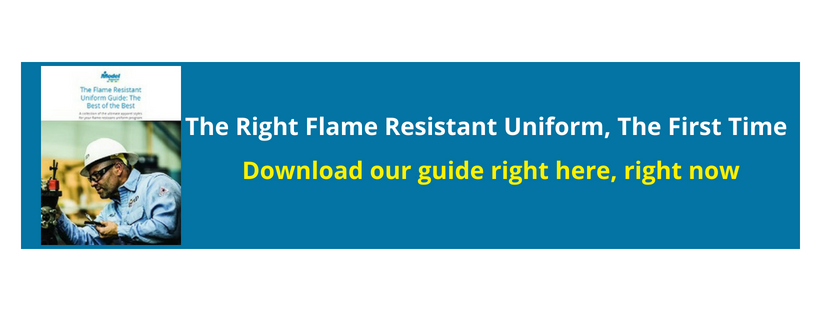When working in certain industries, it's important to wear clothing that will protect you in case of a fire. This level of protection is where FR, or flame resistant, clothing comes in.
But what about other regulations in those industries? Are there regulations that address other safety factors? Another perspective on maintaining a safe workplace involves high visibility clothing. In this article, we'll discuss what FR clothing is and why it's important. We'll also review ANSI compliance standards and how to choose the right FR clothing for your high visibility needs.
What is FR clothing?
Flame resistant clothing is a type of personal protective equipment (PPE). The intent is to protect workers in environments where there is a potential for exposure to flames or electrical arcs. Flame resistant clothing is made from materials that are resistant to ignition. This resistance will not continue to burn once you remove the source of the flame.
You can find FR clothing in a variety of industries, including oil and gas, welding, and electrical. In these industries, workers may experience flames or electrical arcs, which can pose a serious threat to their safety. Wearing FR clothing can help protect workers in these environments. FR clothing helps reduce the severity of burns if they are exposed to flames or electrical arcs.
FR clothing is vital in environments where there is a potential for exposure to flames or electrical arcs. Often, these same environments have other hazards, though. One of the biggest dangers is worker visibility. As job sites operate around the clock, there are people working in all lighting conditions. Dusk and dawn conditions, along with generally poorly lit places, make visibility a challenge. This challenge is why high and enhanced visibility requirements are paired with flame resistant requirements.
ANSI compliance standards
ANSI/ISEA 107-2010 is the most recent version of the standard for high-visibility safety apparel and headwear. The United States, Canada, and Mexico use and follow this standard. The purpose of this standard is to provide minimum requirements for the design, performance, and use of garments worn in hazardous environments. Increasing the visibility of the wearer is it's primary goal.
There are three classes of garments under this standard. Class 1 has the least amount of background material and reflective material, while Class 3 has the greatest amount of background material and reflective material. The type of garment must be appropriate for the work environment. For example, a worker exposed to wet conditions would need a garment made of water-resistant or waterproof materials.
Workers wear Class 1 garments when they have occasional exposure to low-speed traffic. Said another way, their work tasks do not require them to be highly visible. Workers wear Class 2 garments when they have frequent exposure to low-speed traffic or whose work tasks require them to be moderately visible. Workers need Class 3 garments when they have constant exposure to high-speed traffic or whose work tasks require them to be highly visible.
There are two types of reflective materials used in high-visibility clothing: microprismatic and glass bead. Microprismatic materials retroreflect light back to the source, while glass bead materials refract light back to the source. Glass bead materials are more durable than microprismatic materials and help in a wider variety of environments. For more information on reflective and retroreflective materials, see our article that compares the two here.
You must maintain high-visibility clothing properly to continue providing adequate levels of visibility. Cleaning instructions should be followed carefully to avoid damaging the reflective material on the garment.
Comparing enhanced visibility to high visibility
The two main types of enhanced visibility clothing are fluorescent and retroreflective. Fluorescent fabrics help the wearer be seen in low-light conditions, while retroreflective strips or other materials help make the wearer more visible at night. The biggest consideration to make when deciding which type of clothing to wear for work is the level of exposure to traffic or other hazards present in the workplace.
It's important to note that some enhanced or high visibility materials can't hurt, even when they aren't required. Environments such as event security, parking and others might have great light conditions and excellent visibility. Workers often wear enhanced or high visibility clothing here because they can be easily identified. It's important to understand what regulations have an impact on the work you do. See this article for additional info on flourescent fabrics and retroreflective materials for road traffic clothing. These regulations will determine how to keep your team safe at work.
Industries that need high visibility clothing to be flame resistant
FR clothing is most popular in oil and gas, welding, and electrical utility work. As mentioned, FR clothing materials are resistant to ignition and will not continue to burn once you remove the source of the flame. But enhanced and high visibility clothing options can be great additions in these environments.
Oil & Gas
In oil and gas, workers face the danger of oil spills and gas leaks that can ignite. If either of these elements contact an open flame or electrical spark, explosions are imminent. But open flames aren't the only hazard.
Drilling and compressor sites work around the clock. There are always employees and contractors on site. Because people are working all day in this environment, low light conditions are inevitable. Because you have to see people in the dark, enhanced and high visibility clothing is a must.
Welding
Welding needs no explanation. Workers in this environment are exposed to flashes of molten materials. The nature of these substances mean clothing can ignite or melt. But enhanced or high visibility clothing should be considered as well.
Workers perform welding tasks both indoors and outdoors. Again, lighting is of concern in these environments. Workers are often aware when welding is taking place, so they know where the welders are on site. Enhanced or high visibility clothing can help workers identify welders and keep everyone safe.
Electrical utility
Utility workers are one group of workers who need to wear FR clothing. Electrical arcs expose workers while working on power lines or other electrical equipment. Wearing FR clothing can help protect utility workers from serious injuries if they are exposed to an electrical arc.
Enhanced and high visibility are highly recommended for this environment, though. Electrical workers are often working along roadsides, placing them in the way of traffic. Add in the times that workers find themselves working at night, and high and enhanced visibility clothing is critical.
Examples of FR high visibility clothing
FR shirts and vests are two examples of FR high visibility clothing. These items are designed to make the wearer more visible in low-light conditions or at night, and are typically brightly colored with reflective stripes. But as technology and requirements advance, manufacturers are always developing new styles.
When choosing FR high visibility clothing, it is important to select a style that is appropriate for the specific hazards present in the workplace. FR clothing is also available in different levels of protection, depending on the hazard present in the workplace.
Let's take a look at some of the latest FR clothing that also includes enhanced and high visibility elements.

Style: FR Color Block Tee Shirt
Color: HiVis/Navy
Starting at: $153

Style: FR HiVis Work Shirt
Color: Yellow/Green
Starting at: $153

Style: FR Colorblock Pullover Sweatshirt
Color: Yellow Green/Grey
Starting at: $322

Style: FR HiVis Safety Vest
Color: Yellow Green
Starting at: $82

Style: FR HiVis Bomber Jacket
Color: HiVis Yellow
Starting at: $303
How to choose and buy the right FR clothing
We've addressed some of the biggest considerations for buying FR clothing in other articles, so we won't say much differently here. The biggest consideration to make is the level of protection you need for your environment. There are so many options to choose from, but if you don't understand industry regulations, nothing else matters.
Deciding on required levels of protection becomes more important when your team does work in various traffic conditions. ANSI standards help define Type O, Type R and Type P garment types. These create a broader range of protection for high visibility safety apparel. For more reading on these three types, specifically Type O, see our article here.
Comfort is also an important factor to consider when choosing FR and high visibility clothing. Many items of FR clothing are designed to be comfortable enough to wear for extended periods. However, some items may be more constricting or less breathable than others. It is important to select an item that will not cause discomfort during extended wear.
Finally, consider your budget when selecting FR and high visibility clothing. FR shirts and vests can vary widely in price, depending on the brand and features sought. It is important to find an item that fits your budget while still providing adequate protection for the job at hand.
If you're ready to kick off your uniform program but need to finalize the styles your team wears, use our uniform guide to help by selecting the button below. We've found the best styles for your program. No more searching through numerous catalogs. Get the right styles quickly so your team can get to work.
Topics: Flame Resistant, Workplace Safety
.png?width=621&height=373&name=Model-Apparel%20Logo%20File%20from%20Ian%20(1.2).png)
.png)

